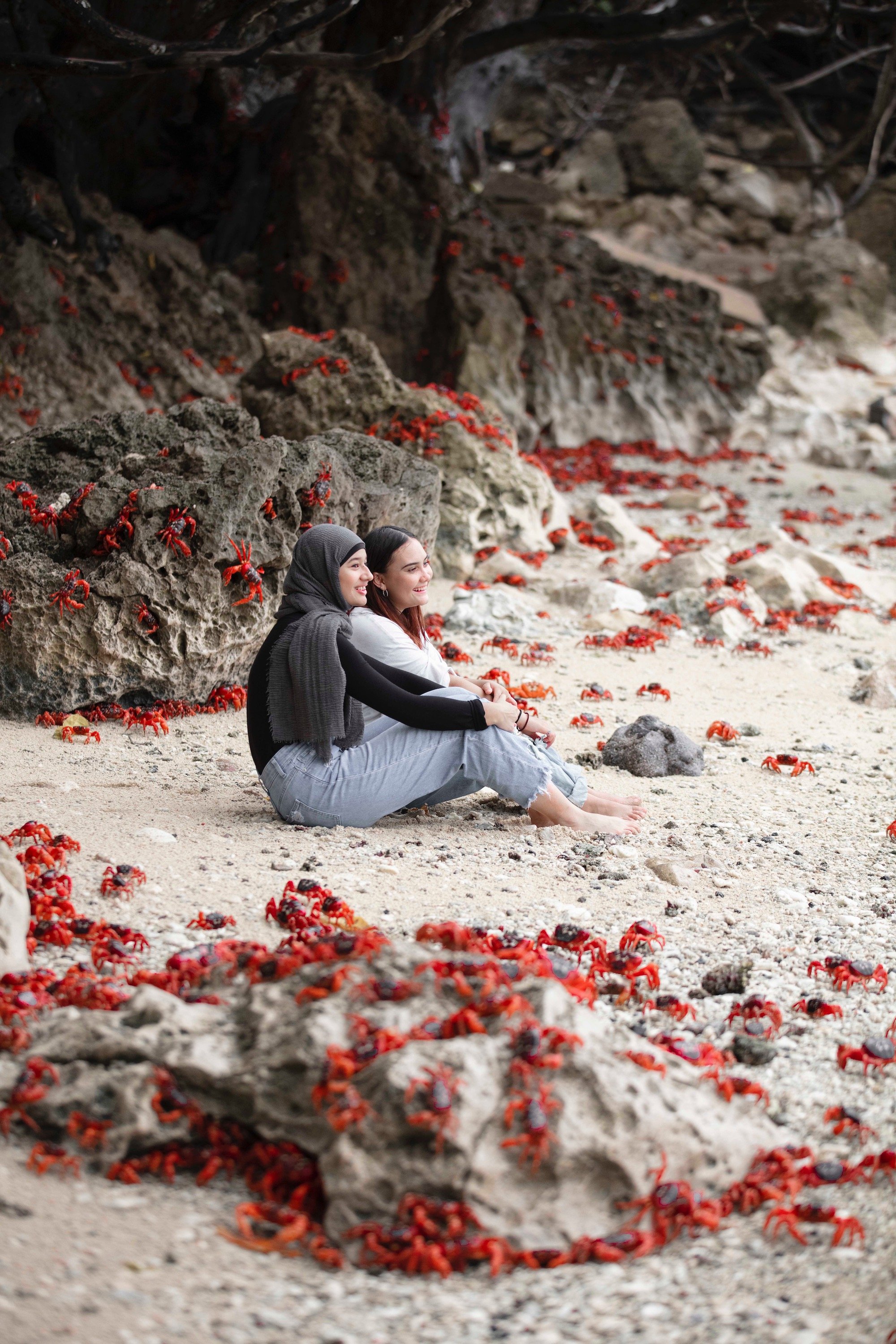
WEATHER & SEASONS
WHEN TO PLAN YOUR CHRISTMAS ISLAND ADVENTURE
The climate is a highlight of Christmas Island, offering a delightful holiday experience year-round. The island's weather differs significantly from other parts of Australia, so it's essential to be aware to best plan your visit.
Throughout the year, Christmas Island boasts warm temperatures, making it an ideal destination for any season. While the air temperature remains a balmy 23-29°C all year, humidity is lowest during the middle of the year May to September (dry season). You will experience some showers from October to April (wet season) where the landscape is adorned in vibrant green. While rain and storms are more prevalent during this period, full-day showers are rare. You can still expect sunny days with occasional passing storms.
During April to October (the dry season) there are endless adventures to be had on island or unwind on the beach with generally drier days and calm seas. The ocean temperature is warm all year round, ranging from 26 to 29°C.
Discover the unique charm of each season on Christmas Island below.
christmas island
CLIMATE & SEASONs

SUMMER | wET SEASON
DECEMBER | JANUARY | FEBRUARY
AVERAGE TEMPERATURES: 22-28 DEGREES
AVERAGE RAINFALL: 12 DAYS DEC |15 DAYS JAN | 17 DAYS FEB
Summer (December - February) is Christmas Island's Wet Season. The commencement of the awe-inspiring red crab migration begins with the onset of the initial rains. This remarkable and somewhat unpredictable spectacle typically occurs between October and December, lasting approximately two months. The potential migration spawning dates can be viewed at the bottom of this page. This incredible natural phenomonon provides a truly spectacular experience for those fortunate enough to witness it. However, it's important to note that this event can pose logistical challenges for travelers, necessitating thorough preparation.
Wet Season Road Closures
The wet season prompts the closure of several island roads to vehicles to facilitate the safe passage of migrating crabs. While navigating on foot or by bike is still possible, the island's mountanous terrain and considerable distances should be taken into account. Although the closed roads offer enchanting walks through the lush, crab-covered jungle, visitors who may struggle with the typical wet season conditions—humidity, hills, or extensive hiking—might need to forgo certain adventurous activities and instead indulge in the relaxation of their accommodations with nearby alternatives.
Driving on the island can also be a leisurely affair during this period, as Christmas Island National Parks and volunteers diligently clear roads of crabs. It presents an opportune time to immerse yourself in the unhurried rhythm of island life in all its natural beauty.
Other Considerations
The wet season heightens the possibility of flight disruptions due to adverse weather conditions. Changes in ocean swell can also affect water-based activities such as boating, diving, and snorkeling. A number of local dive operators close over this period. Fortunately, the beauty of being on an island provides versatility and allows for calmer bays and beaches on the opposite side, offering serene conditions for snorkelling.
Despite the occasional challenges, the Christmas Island wet season remains a busy time of the year and an incredible season to visit, particularly embraced by those who relish adventure. While it may be better suited for more physically fit visitors, the intermittent disruptions only add to the richness of stories forged during Christmas Island adventures.
AUTUMN
MARCH | APRIL | MAY
AVERAGE TEMPERATURES: 23-28 DEGREES
AVERAGE RAINFALL: 18 DAYS MAR |15 DAYS APR| 11 DAYS MAY
After the significant rain fall from the start of wet season on Christmas Island, this is when nature continues to come alive. Like a time-lapse before your eyes, the landscape quickly transforms from the warm tones of the dry to fresh green tones of lush tropical forests with bouts of warm, therapeutic rain. Let summer live on in Autumn on Christmas Island, where the landscape becomes a tropical haven, waterways brim with life, and panoramic vistas paint spectacular vistas.
This period sees the reopening of many local operators, having been temporarily closed during the wet season peak. It’s a great opportunity to dive back into the water for scuba diving, learn to freedive the depths or board on a charter boat to go fishing. Local tropical produce including mangoes, bananas, dragonfruit, papaya and avocadoes adorn the trees. This vibrant harvest coincides with the lively atmosphere of the island, teeming with unique wildlife—from birds and crabs to flying foxes and butterflies. Splash through puddles, dance in the rain and see the rainforest come alive with glossy raindrops in all of its green glory.
WINTER | dRY sEASON
JUNE | JULY | AUGUST
AVERAGE TEMPERATURES: 22-27 DEGREES
AVERAGE RAINFALL: 10 DAYS JUN |8 DAYS JUL| 6 DAYS AUG
Welcome to the place where your typical idea of winter doesn’t really exist. Christmas Island's dry season between June and August brings with it lower humidity, picturesque sunsets, blue skies and of course less rain. The beach is the place to be and in adventuring the warm waters that surround the island is a favourite winter pastime on island.
The winter escape to Christmas Island is popular and it’s not hard to see why. Coming to Christmas Island in the dry season means you’ll still get to see red crabs around the Island, and plenty of other sights that are often inaccessible during their migration. While many other destinations are huddled inside around heaters, on Christmas Island you can indulge in diving, fishing and beach days with balmy nights of cocktails beneath the palms.
A dry season holiday means you’ll be more likely to experience the best snorkelling spots too with low swell and light winds. Water and outside temperatures both hover around the mid-twenties (Celsius) making the tropical shores the perfect place to hang out on a warm, sunny winter day.
SPRING
SEPTEMBER | OCTOBER | NOVEMBER
AVERAGE TEMPERATURES: 22-27 DEGREES
AVERAGE RAINFALL: 4 DAYS SEP |4 DAYS OCT| 7 DAYS NOV
Embark on a tropical prelude to summer with a spring holiday to Christmas Island. Bask in the glow of sunny days, inviting you to unwind in the warm embrace of clear ocean waters. As the initial rains of the wet season grace the island between October to December, a mesmerising transformation unfolds with red crabs emerging from the jungle, embarking on their annual migration to the coastline. Divers and snorkelers may even encounter the graceful presence of whale sharks, feeding on red crab larvae during this spectacular spawn.
Christmas Island gives you the quintessential summer experience early, when you choose to visit in spring. Birdwatchers will have plenty to see year round, while the dry season is ideal for bushwalking.
With consistently warm temperatures throughout the year, paired with crystal-clear waters and a kaleidoscope of wildlife both above and below the surface, every season on Christmas Island unfolds as a magical chapter waiting to be explored.
Possible RED CRAB spawning dates for 2024/25
15-16 November
16-17 December
14-15 January (2026)
Spawning could occur a day either side of these dates as well. Migration would typically start about 4-5 weeks before these spawning dates and is triggered by suitable rain.

CHRISMAS ISLAND ITINERARIES.
How to experience the best Christmas Island has to offer... from wandering to secluded stretches of paradise and encountering those bucket list wildlife moments, to taking the plunge to depths you’ve never ventured.





